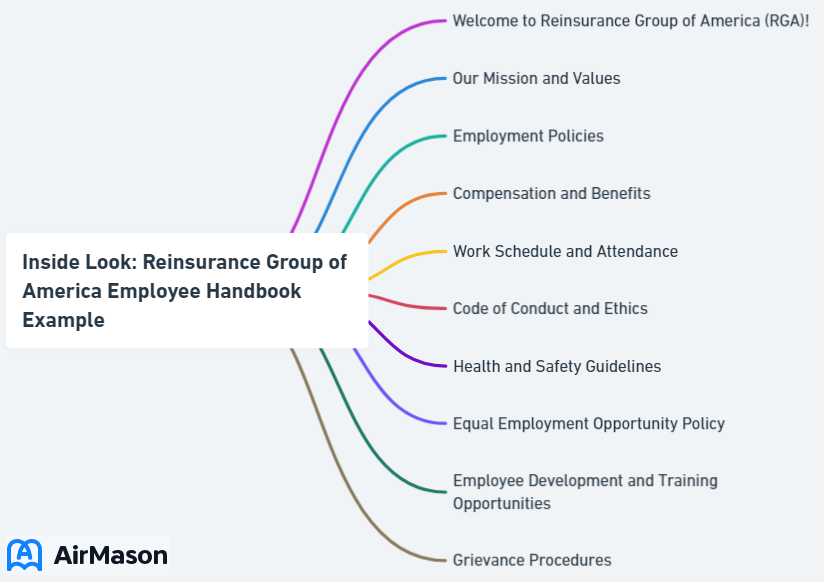
Navigating the world of employee handbooks can be a challenging endeavor, especially for businesses aiming to create a strong foundation for their workplace practices. The Reinsurance Group of America Employee Handbook Example serves as a prime illustration of an effective and comprehensive guide, designed to ensure a thriving work environment for all. Let’s embark on a journey to uncover the secrets behind the success of this employee handbook and how it can serve as an inspiration for your own business.
In this blog post, we will explore the key elements of the Reinsurance Group of America Employee Handbook Example, discuss the importance of creating an effective employee handbook for your business, and delve into the topics of employee health and safety, data privacy, and other essential matters. So, let’s dive in and discover the world of RGA’s employee handbook and how it can pave the way for a prosperous and harmonious workplace.
Key Takeaways
- RGA Employee Handbook promotes exploration, diversity and employee welfare through comprehensive policies.
- Employee handbook should include organizational details, compensation & benefits, code of conduct and equal employment regulations.
- Employers must comply with relevant legal requirements to ensure a safe work environment including data protection laws & workplace safety protocols.
Fortune 500 Companies Employee Handbook
Welcome to the Fortune 500 Companies Employee Handbook, a comprehensive guide designed to ensure that every member of our esteemed workforce has access to essential information and guidelines. In this Fortune 500 Companies Employee Handbook, you will find a wealth of valuable resources, from company policies to employee benefits. Our commitment to fostering a positive and inclusive workplace is reflected in the contents of this handbook, which aims to empower you with the knowledge and tools needed for success. As you navigate through these pages, consider this handbook your go-to resource for understanding the values, expectations, and opportunities that come with being a part of our dynamic Fortune 500 organization.
Understanding the Reinsurance Group of America Employee Handbook
The RGA Employee Handbook stands out due to its comprehensive set of regulations and expectations for business operations, fostering a culture that encourages exploration and problem-solving. This user-friendly guide also highlights the importance of diversity and inclusivity in the workplace, promoting a safe and healthy environment by prohibiting violence and harassment and adhering to legal obligations.
The handbook outlines various policies, such as:
- Code of Conduct and Ethics
- Privacy Policy
- Human Resources Policy
- Insider Trading Policy
- Equal Opportunity Policy
These policies encourage employees to provide feedback and maintain open communication.
The RGA Employee Handbook also places a high priority on employee benefits and welfare. It provides assistance programs, physical and mental well-being support, and access to physical fitness facilities and mental health resources. This holistic approach contributes to better decision making and overall employee satisfaction.
Key Elements of the RGA Employee Handbook
The RGA Employee Handbook is designed to be user friendly, encompassing organizational particulars, remuneration and advantages, code of behavior, leave of absence regulations, and equal employment and non-discrimination regulations. The handbook takes the necessary steps to ensure compliance with employment laws, such as applying the policy globally to all workforce members, complying with all applicable laws, promoting a safe work environment, and providing required training to employees.
In terms of company policies and procedures, the RGA expects employees to refer to applicable policies and guidelines, in addition to the Code of Conduct when considering company policies and procedures. This approach ensures that employees are well-versed in the company’s expectations and can contribute effectively to a thriving workplace.

How the RGA Employee Handbook Aligns with Relevant Laws
Compliance with relevant local and international laws and regulations concerning human rights is a priority for the RGA Employee Handbook. The handbook takes measures to ensure compliance with employment laws, such as:
- Applying the policy globally to all workforce members
- Complying with all applicable laws
- Promoting a safe work environment
- Providing required training to employees
The handbook also addresses legal matters concerning privacy and personal information.
To maintain accuracy and compliance with the ever-changing laws and regulations, RGA regularly reviews and updates the Employee Handbook at least once a year. RGA implements several steps to guarantee that all employees comprehend and adhere to the laws outlined in the Employee Handbook, including:
- Documenting policies and procedures
- Consistently applying policies
- Ensuring employees are aware of the policies through effective communication and training programs.
Creating an Effective Employee Handbook for Your Business

An effective employee handbook is essential in establishing clear workplace practices and expectations, as well as ensuring employer and employee compliance with relevant laws and regulations. Key components of an effective employee handbook encompass:
- Organizational details
- Compensation and benefits
- A code of conduct
- Leave policies
- Equal employment and non-discrimination rules
The upcoming sections will cover the importance of clear internal policies, employee training and support, and the promotion of open communication and feedback.
Establishing Clear Internal Policies
Clear internal policies in an employee handbook are key to promoting a smoothly operating work environment. Best practices involve:
- Ensuring that policies are clear, focused, and consistent
- Appointing a policy manager
- Determining the necessary policies
- Defining the workflow
- Collaborating with internal stakeholders
- Vetting the policies with relevant parties
- Categorizing policies into clear and distinct areas
Appointing a policy manager with the right experience, knowledge, and skills is essential, as they should have a comprehensive understanding of the company’s policies and procedures, as well as applicable laws and regulations.
When identifying and categorizing policies, it is important to consider the company’s objectives and any applicable laws and regulations. Policies should be properly organized into distinct categories, such as employee policies, safety policies, and data protection policies, ensuring that policies are easily accessible and understandable.
Providing Training and Support for Employees
Employee training and support are vital for their understanding and adherence to company policies. Here are some steps to ensure effective training and support:
- Encourage questions and provide training sessions or workshops to familiarize employees with the handbook and its content.
- Collaborate with HR teams and managers to ensure the handbook covers all relevant information.
- Inform employees of their rights and benefits through the handbook.
By following these steps, you can ensure that employees have a clear understanding of company policies and feel supported in their roles.
The employee handbook can effectively facilitate employee training by providing a comprehensive guide that outlines the company’s policies, expectations, and values. It serves as a reference point for employees to understand their roles and responsibilities, as well as the rules and regulations they need to adhere to. Additionally, the handbook can include training materials, procedures, and resources to support employees in their learning and development endeavors.
Viatris Employee Handbook Example
In the realm of corporate guidelines and workplace policies, the Viatris Employee Handbook serves as an exemplary model. The “Viatris Employee Handbook Example” encapsulates the company’s commitment to fostering a positive and inclusive work environment. This comprehensive document not only outlines the standard operating procedures but also reflects Viatris’s dedication to employee well-being and professional growth. From clear communication channels to transparent performance expectations, the handbook stands as a testament to Viatris’s emphasis on creating a workplace where individuals can thrive. As employees navigate through its pages, they discover a wealth of information designed to empower and guide them, reinforcing Viatris’s values of integrity, innovation, and collaboration.
Encouraging Open Communication and Feedback
A thriving workplace requires open communication and feedback, which can enhance employee engagement and productivity, build trust, foster a sense of purpose and accountability, stimulate innovation, and reduce conflicts and early problem detection.
To promote open communication and feedback in a company, you can:
- Implement an open-door policy
- Encourage feedback from employees
- Establish ground rules for communication
- Practice active listening
These policies can help create a culture of open communication and feedback in the workplace.
To create a culture of open communication and feedback, employers should:
- Encourage employees to share their ideas and feedback
- Offer feedback opportunities
- Cultivate a culture of respect
- Practice active listening
- Schedule team meetings
- Utilize collaborative tools
- Establish feedback channels
Protecting Employee Health and Safety in the Workplace

Ensuring employee health and safety in the workplace is a fundamental aspect of any business. Employers are responsible for ensuring a safe and healthy work environment for their employees, and it is important to be aware of the legal requirements for workplace safety in the USA, such as:
- The Occupational Safety and Health Act (OSHA)
- The Americans with Disabilities Act (ADA)
- The Family and Medical Leave Act (FMLA)
- The Fair Labor Standards Act (FLSA)
- The Equal Employment Opportunity Commission (EEOC)
By understanding and complying with these regulations, employers can create a safe and healthy workplace for their employees.
The upcoming sections will cover the legal requirements for workplace safety and the implementation of health and safety policies.
Legal Requirements for Workplace Safety
The Occupational Safety and Health Act (OSHA) outlines the legal requirements for workplace safety in the USA. This act was enacted by Congress to guarantee worker and workplace safety. Employers must furnish a safe and healthy work environment for their employees. Since workplace safety laws can differ by state, employers should stay updated on safety standards and regulations in each state where they operate.
To find the most current information on workplace safety laws and regulations, you can visit the website of the Occupational Safety and Health Administration (OSHA) at https://www.osha.gov.
Implementing Health and Safety Policies
The essential components of a health and safety policy encompass a defined declaration of intent, a structured system for health and safety obligations, objectives and policies for safety, safety assurance, risk management, safety promotion, and employee feedback. To ensure employee compliance with health and safety policies, employers can provide comprehensive training to ensure employees are cognizant of the policies and comprehend their duties, establish transparent policies and enforce them uniformly to set standards for conduct, involve employees by including them in the formation of policies and seeking their feedback on safety measures, and secure supervisor endorsement to emphasize the significance of compliance and supply guidance to employees.
Health and safety policies are critical to ensure staff safety and protect the company from potential legal and financial risks. They aid in creating a secure and productive work atmosphere, which can result in enhanced employee morale and efficiency.
Managing Employee Data and Privacy

Handling employee data and privacy is a significant part of workplace practices. Employers need to be aware of their legal obligations in handling employee data and ensure compliance with relevant laws and regulations.
The upcoming sections will cover adherence to data protection laws and optimal practices for managing employee data.
Compliance with Data Protection Laws
Key data protection laws pertinent to employee data management include:
- General Data Protection Regulation (GDPR)
- California Consumer Privacy Act (CCPA)
- Health Insurance Portability and Accountability Act (HIPAA)
- Fair Credit Reporting Act (FCRA)
- Employee Retirement Income Security Act (ERISA)
Employers are obligated to adhere to GDPR regulations when processing personal data of employees, including providing appropriate information to job candidates prior to collecting and processing their personal data.
The key responsibilities of a Data Protection Officer (DPO) include:
- Managing a company’s data protection strategy
- Ensuring compliance with data protection laws
- Monitoring compliance
- Creating awareness about data protection obligations
- Providing advice on data protection
The DPO plays a crucial role in safeguarding the privacy and security of personal data.
Best Practices for Handling Employee Data
To limit unauthorized access to employee data, implement access controls like authorized access and permissions, unique user accounts with distinct passwords, and two-factor authentication. Employee data can be secured by employing encryption algorithms, such as AES-256, and secure protocols, such as TLS/SSL.
The HR department should be provided with training on data handling and privacy best practices, including familiarity with data protection laws, implementation of data security policies, and recognition of the significance of data privacy. By following these best practices, employers can ensure the proper management of employee data and privacy.
Addressing Other Matters in the Employee Handbook
Beyond the previously discussed topics, the employee handbook should also cover the company’s code of conduct, policies on workplace harassment and discrimination, and statements on diversity and inclusion. A code of conduct in an employee handbook is essential for establishing the expectations and standards of behavior for employees in the workplace, promoting a positive work culture, encouraging ethical behavior, and guaranteeing uniformity in employee conduct.
To address workplace harassment and discrimination, an employee handbook should include:
- A clear policy statement that prohibits such behaviors
- Examples of prohibited behaviors and specify consequences
- An established complaint process
- Anti-harassment training
- Emphasis on the company’s commitment to a discrimination-free work environment.
Including a diversity and inclusion statement in an employee handbook is also vital, as it reflects the organization’s commitment to creating an inclusive and diverse workplace, and promotes a sense of belonging and respect for all employees.
Summary
In conclusion, crafting an effective employee handbook, such as the RGA Employee Handbook, can significantly impact the success and harmony of a workplace. By addressing key areas such as clear internal policies, employee training and support, open communication and feedback, employee health and safety, data privacy, and other essential matters, a well-rounded employee handbook can serve as a valuable tool for any business.
Remember, the employee handbook is much more than just a collection of policies and procedures; it is a reflection of your company’s culture, values, and commitment to its employees. By creating a comprehensive and user-friendly employee handbook, you are investing in your employees’ well-being, productivity, and satisfaction, ensuring a prosperous future for your business.
Frequently Asked Questions
What is Reinsurance Group of America do?
Reinsurance Group of America (RGA) is a leading provider of reinsurance solutions with a focus on life and health-related products. They offer core services such as life reinsurance, living benefits reinsurance, group reinsurance, health reinsurance, financial solutions, facultative underwriting, product development, bancassurance, retakaful, risk management, electronic underwriting and client training.
Who owns the reinsurance group of America?
MetLife acquired General American in 2000, and after 8 years of ownership spun RGA off to become an independent company. MetLife now owns 65% of the reinsurance group of America (RGA).
What are the main features of the RGA Employee Handbook?
The RGA Employee Handbook provides comprehensive regulations and expectations for business operations, encourages exploration and problem-solving, and promotes diversity and inclusivity. It also contains policies prohibiting violence and harassment while adhering to legal obligations.
How can an employee handbook facilitate employee training?
The employee handbook can effectively facilitate employee training by providing a comprehensive guide of the company’s policies, expectations, and values. It serves as a reference for employees to understand their roles, responsibilities, rules, and regulations, as well as providing them with training materials, procedures, and resources.
What are the legal requirements for workplace safety in the USA?
Under the Occupational Safety and Health Act (OSHA), employers are required to provide a safe and healthy working environment for their employees in the USA. Congress enacted the act to guarantee worker and workplace safety.
Important Disclaimer:
The article presented here does not serve as a representation of the company’s actual employee handbook mentioned in this article.
Our discussions and insights regarding employee handbook are based on assumptions about what may be considered significant in the companies’ policies. These assumptions are drawn from available information and industry knowledge. Readers are advised that the content provided is for informational purposes only and should not be construed as an exact reflection of any company’s official policies or procedures. For precise and accurate details regarding a company’s employee handbook, individuals should refer directly to the company’s official documentation or consult with appropriate representatives.
Please be aware that the content on this page has been generated by using artificial intelligence language models and may contain errors, inconsistencies, or outdated information. It is provided as-is without any warranties or guarantees of accuracy. We strongly recommend using this content as a starting point for further research. We disclaim any liability for damages or losses resulting from the use or reliance on this content.